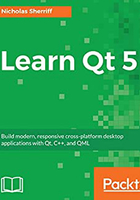
Conventions used
There are a number of text conventions used throughout this book.
CodeInText: Indicates code words in text, database table names, folder names, filenames, file extensions, pathnames, dummy URLs, user input, and Twitter handles. Here is an example: "Create the SplashView.qml file in cm-ui/ui/views".
A block of code is set as follows:
<RCC> <qresource prefix="/views"> <file alias="MasterView">views/MasterView.qml</file> </qresource> <qresource prefix="/"> <file>views/SplashView.qml</file> <file>views/DashboardView.qml</file> <file>views/CreateClientView.qml</file> <file>views/EditClientView.qml</file> <file>views/FindClientView.qml</file> </qresource> </RCC>
When we wish to draw your attention to a particular part of a code block, the relevant lines or items are set in bold:
QT += sql network
Any command-line input or output is written as follows:
$ <Qt Installation Path> \Tools \QtInstallerFramework \3.0\ bin\ binarycreator.exe -c config\config.xml -p packages ClientManagementInstaller.exe
Bold: Indicates a new term, an important word, or words that you see onscreen. For example, words in menus or dialog boxes appear in the text like this. Here is an example: "Replace the Hello World title with Client Management and insert a Text component inside the body of the Window".